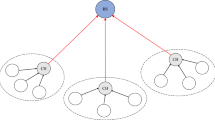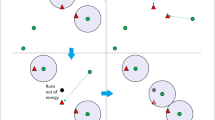Abstract
Wireless Sensor Network (WSN) is widely used for collecting the information from the target region by deploying the sensor nodes in that region. In WSNs, energy saving is the prime task which depends upon the number of Cluster Heads (CH) and on their selection techniques. Thus, in order to optimize the energy consumption of the clusters, we are proposing an Energy-efficient technique for selection of Optimum Number of Cluster Head and Grid Head (EOCGS) which extends the network lifetime. Here, firstly we give the expression of optimum number of clusters, then propose a new technique for selecting the optimum number of CHs in an energy efficient manner. For saving the energy of the CHs, the concept of Grid Head (GH) is being added in an efficient way, which works in dynamic mode. When the number of CHs are greater than threshold limit, then few of the CHs work as GHs and they are selected by using the proposed fitness function that depends on residual energy, Euclidean distances, and location of the grid-centroid of CHs. We have depicted that the proposed work saves the network energy efficiently, extends the network lifetime and coverage as compared to similar clustering algorithms e.g., LEACH, TL-LEACH, R-LEACH, RCH-LEACH, UCRA-GSO & CCA-GWO. It also stabilizes the cluster formation in the network.












Similar content being viewed by others
References
Xiang, W., Wang, N., & Zhou, Y. (2016). An energy-efficient routing algorithm for software-defined wireless sensor networks. IEEE Sensors Journal, 16(20), 7373–7400.
Zhang, Y., Chen, M., Huang, D., Wu, D., & Li, Y. (2017). iDoctor: Personalized and professionalized medical recommendations based on hybrid matrix factorization. Future Generation Computer Systems, 66, 30–35.
Zhong, C. l., Zhu, Z. & Huang, R. G. (2017). Study on the IOT architecture and access technology. \(16^{th}\)Symposium on distributed computing and applications to business, engineering and science (DCABES), anyang, pp. 113–116.
Zhang, H., Li, J., Wen, B., Xun, Y., & Liu, J. (2018). Connecting intelligent things in smart hospitals using NB-IoT. IEEE Internet of Things Journal, 5(3), 1550–1560.
Lee, H. C., & Ke, K. H. (2018). Monitoring of large-area IoT sensors using a LoRa wireless mesh network system: Design and evaluation. IEEE Transactions on Instrumentation and Measurement, 67(9), 2177–2187.
Potdar, V., Sharif, A. & Chang E. (2009). Wireless sensor networks: A survey. International conference on advanced information networking and applications workshops, Bradford, pp. 636–641.
Ozdemir, S., & Xiao, Y. (2009). Secure data aggregation in wireless sensor networks: A comprehensive overview. Computer Network, 53(12), 2022–2037.
Kuila, P., & Jana, P. K. (2014). Approximation schemes for load balanced clustering in wireless sensor networks. The Journal of Supercomputing, 68, 87–105.
Bharti, S., Pattanaik, K. K., & Pandey, A. (2020). Contextual outlier detection for wireless sensor networks. Journal of Ambient Intelligence and Humanized Computing, 11, 1511–1530.
Fanian, F., & Rafsanjani, M. K. (2019). Cluster-based routing protocols in wireless sensor networks: A survey based on methodology. Journal of Network and Computer Applications, 142, 111–142.
Xu, L., Collier, R., & O’Hare, G. M. P. (2017). A survey of clustering techniques in WSNs and consideration of the challenges of applying such to 5G IoT scenarios. IEEE Internet of Things Journal, 4(5), 1229–1249.
Yetgin, H., Cheung, K. T. K., El-Hajjar, M., & Hanzo, L. H. (2017). A survey of network lifetime maximization techniques in wireless sensor networks. IEEE Communications Surveys & Tutorials, 19(2), 828–854.
Heinzelman, W. B., Chandrakasan, A. P., & Balakrishnan, H. (2002). An application-specific protocol architecture for wireless microsensor networks. IEEE Transactions on Wireless Communications, 1(4), 660–670.
Handy, M. J., Haase, M. & Timmermann, D. (2002). Low energy adaptive clustering hierarchy with deterministic cluster-head selection. \(4^{th}\)International workshop on mobile and wireless communications network, pp. 368–372.
Zhixiang, D., & Bensheng, Q. (2007). Three-layered routing protocol for WSN based on LEACH algorithm. IET conference on wireless, mobile and sensor networks (CCWMSN07), Shanghai, pp. 72–75.
Panchal, A., & Singh, A. K. (2020). LEACH based clustering technique in wireless sensor network. Test Engineering & Management, 82, 4185–4188.
Behera, T. M., Mohapatra, S. K., Samal, U. C., Khan, M. S., Daneshmand, M., & Gandomi, A. H. (2019). Residual energy-based cluster-head selection in WSNs for IoT application. IEEE Internet of Things Journal, 6(3), 5132–5139.
Panchal, A., Singh, L. K. & Singh, R. K. (2020). RCH-LEACH: Residual energy based cluster head selection in LEACH for wireless sensor networks. International conference on electrical and electronics engineering (ICE3), Gorakhpur, India, pp. 322–325.
Hoang, D. C., Kumar, R., & Panda, S. K. (2010). Fuzzy C-Means clustering protocol for Wireless Sensor Networks (pp. 3477–3482). Bari: IEEE international symposium on industrial electronics.
Gustafson, D. E. & Kessel, W. C. (1978). Fuzzy clustering with a fuzzy covariance matrix. IEEE conference on decision and control including the\(17^{th}\)Symposium on adaptive processes, San Diego, CA, USA, pp. 761–766.
Yang, M. S. (1993). A survey of fuzzy clustering. Mathematical and Computer Modelling, 18, 1–16.
Ni, Q., Pan, Q., Du, H., Cao, C., & Zhai, Y. (2017). A novel cluster head selection algorithm based on fuzzy clustering and particle swarm optimization. IEEE/ACM Transactions on Computational Biology and Bioinformatics, 14(1), 76–84.
Panchal, A. & Singh, R. K. (2020). EADCR: Energy aware distance based cluster head selection and routing protocol for wireless sensor networks. Journal of Circuits, Systems, and Computers. https://doi.org/10.1142/S0218126621500638.
Panchal, A. & Singh, R. K. (2021). EHCR-FCM: Energy efficient hierarchical clustering and routing using Fuzzy C-Means for wireless sensor networks. Telecommunication Systems, Springer, 76, pp. 251–263.
Mittal, N., Singh, U., & Sohi, B. S. (2017). A stable energy efficient clustering protocol for wireless sensor networks. Wireless Networks, 23, 1809–1821.
Alami, H. El & Najid, A. (2019). ECH: An enhanced clustering hierarchy approach to maximize lifetime of wireless sensor networks. IEEE Access, 7, pp. 107142–107153.
Khabiri, M., & Ghaffari, A. (2018). Energy-aware clustering-based routing in wireless sensor networks using cuckoo optimization algorithm. Wireless Personal Communications, 98, 2473–2495.
Xiuwu, Y., Qin, L., Yong, L., Mufang, H., Ke, Z., & Renrong, X. (2019). Uneven clustering routing algorithm based on glowworm swarm optimization. Ad Hoc Networks, 93, 1–8.
Chandirasekaran, D., & Jayabarathi, T. (2019). Cat swarm algorithm in wireless sensor networks for optimized cluster head selection: A real time approach. Cluster Computing, 22, 11351–11361.
Bozorgi, S. M., & Bidgoli, A. M. (2019). HEEC: A hybrid unequal energy efficient clustering for wireless sensor networks. Wireless Networks, 25, 4751–4772.
Daneshvar, S. M. M. H., Mohajer, P. A. A., & Mazinani, S. M. (2019). Energy-efficient routing in WSN: A centralized cluster-based approach via Grey Wolf optimizer. IEEE Access, 7, 170019–170031.
Iwendi, C., Maddikunta, P. K. R., Gadekallu, T. R., Lakshmanna, K. A., Bashir, K., & Piran, M. J. (2020). A Metaheuristic optimization approach for energy efficiency in the IoT networks. Software: Practice and Experience. https://doi.org/10.1002/spe.2797
Maddikunta, P. K., Gadekallu, T. R., Kaluri, R., Srivastava, G., Parizi, R. M., & Khan, M. S. (2020). Green communication in IoT networks using a hybrid optimization algorithm. Computer Communications, 159, 97–107. https://doi.org/10.1016/j.comcom.2020.05.020.
Alazab, M., Lakshmanna, K., Reddy, T. G., Pham, Q.-V., & Maddikunta, P. K. R.. (2020). Multi-objective cluster head selection using fitness averaged rider optimization algorithm for IoT networks in smart cities. Sustainable Energy Technologies and Assessments. https://doi.org/10.1016/j.seta.2020.100973.
Chandrawanshi, V. S., Tripathi, R. K., & Pachauri, R. (2018). Optimum number of clusters in randomly distributed wireless sensor networks. International Journal of Engineering and Technology, 7(2), 61–64.
Heinzelman, W. R., Chandrakasan, A. & Balakrishnan, H. (2000). Energy-efficient communication protocol for wireless microsensor networks. Proceedings of the\(33^{rd}\)annual Hawaii international conference on system sciences, Maui, HI, USA, pp. 1–10.
Panchal, A. & Singh, R. K. (2020). FFTHR: Fitness function based two hop routing in WSN. Internet Technology Letters. https://doi.org/10.1002/itl2.217..
Panchal, A., & Singh, R. K. (2019). REHR: Residual energy based hybrid routing protocol for wireless sensor networks. IEEE Conf. on Info. and Comm. Tech., IIIT-Allahabad, India, pp. 1–5.
Nudurupati, D. P., & Singh, R. K. (2013). Enhancing coverage ratio using mobility in heterogeneous wireless sensor networks. CIMTA, 10, 538–545.
Author information
Authors and Affiliations
Corresponding author
Additional information
Publisher's Note
Springer Nature remains neutral with regard to jurisdictional claims in published maps and institutional affiliations.
Appendix
Appendix
1.1 Optimum number of clusters
Here, we are deriving the expression for the optimum number of clusters based on the energy consumption of CMs, CHs and GHs of the network, where the energy consumption by each CM & CH individually can be expressed by Eqs. 6 & 7 respectively, and the energy consumption by GHs is expressed by Eq. 8. We know that in the three layer structure, CMs and CHs follow \(d^{2}\) energy model (Eq. 5) because their distances from their destination are less than the threshold distance (\(d_{th}\)), while each GH directly communicate with the BS, thus it may follow \(d^{4}\) energy model due to their large distances from the BS [15]. Now, the energy consumption of the whole network is given as,
where \(E_{cluster}\) describes the energy consumption of the cluster, \(N_{G_{C}}\) denotes the total number of clusters in a grid and \(E_{GHs}\) denotes the energy consumption by among GHs (Eq. 8). As we know that the \(N_{CH}\) is distributed into \(N_{GH}\) grids, thus \(N_{G_{C}}\) can be defined as,
Here, we are evaluating the value of \(E_{cluster}\) using the following expression,
Now, the value of \(E_{n}\) & \(E_{CH}\) is taken from Eqs. 6 & 7, and put in the above Eq. 26 as
In the above equation, replace the value of \(n_{c}\) from Eq. 8 as,
Now, we are taking the expressions of \(E_{GHs}\), \(N_{GH}\) & \(E_{cluster}\) from Eqs. 8, 25 and 28, and place into Eq. 24 as,
Now, the above equation can be simplified as,
Here, we are giving the expression for the expected value of square of E.d. of CMs (\(\bar{E}[d_{n2CH}^2]\)) and CHs (\(\bar{E}[d_{CH2GH}^2]\)) from their destination. For this, we have assumed that the nodes are uniformly distributed and each cluster is having circular dimension. Thus, the radius (\(R_{c}\)) and node density (\(\rho _{c}(\bar{r},\theta )\)) of the clusters are same as described in [35], and can be expressed as,
Here, the expression of \(\bar{E}[d_{n2CH}^2]\) can be given as,
Similarly, the expression of \(\bar{E}[d_{CH2GH}^2]\) can be given as,
where \(R_{g}\!=\!\frac{M}{\sqrt{\pi N_{GH}}}\) & \(\rho _{g}\!=\!\frac{N_{GH}}{M^{2}}\) denote the radius and node density of the grid respectively. Now, the value of \(\bar{E}[d_{n2CH}^2]\) & \(\bar{E}[d_{CH2GH}^2]\) put in Eq. 30
In order to get the optimum value of \(N_{CH}\) i.e., (\(N_{CH}^{opt}\)), we differentiate Eq. 38 w.r.t. \(N_{CH}\) and equate it to zero,
Rights and permissions
About this article
Cite this article
Panchal, A., Singh, R.K. EOCGS: energy efficient optimum number of cluster head and grid head selection in wireless sensor networks. Telecommun Syst 78, 1–13 (2021). https://doi.org/10.1007/s11235-021-00782-1
Accepted:
Published:
Issue Date:
DOI: https://doi.org/10.1007/s11235-021-00782-1




